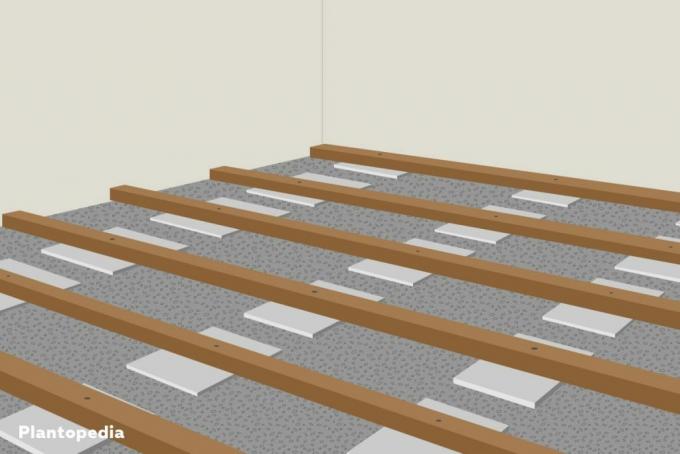
table of contents
- Definition: foundations
- Different variations
- bar
- Cast foundations
- Wooden tiles with lattice
- Adjustable feet
- frequently asked Questions
The foundation of a wooden terrace is largely responsible for its stability and service life. We show here how the structure should turn out.
In a nutshell
- Foundation has an important function
- different variants possible
- Different points must be observed for each version
- direct contact with the ground is to be avoided in any case
- Water drainage and compensation of unevenness are ensured by the substructure
Definition: foundations
A foundation is a substructure on which the wooden terrace is built. It fulfills several functions at the same time. Including:
- Create distance to the ground
- Compensate for height differences
- Increase stability
- Improve water drainage
A direct contact between earth or a lack of drainage of the water ensures that the On the one hand, wooden terrace is more complex to maintain and, on the other hand, it has a significantly shorter lifespan having. Because if the wood is moist or even wet again and again, putrefaction and thus decomposition sets in. If the wooden floorboards or wooden tiles lie on top of the floor without any clearance, they will rot very quickly.
Different variations
With the foundations for the wooden terrace, there are sometimes big differences in the structure. However, some steps are the same. These include:
- Level the ground
- Do not exceed a gradient of one to two percent
- ensure good water drainage
Note: These factors are independent of whether it is a so-called floating or a solid foundation.
bar
A comparatively simple variant of the foundation for your wooden terrace is placing beams under it. There are various ways of doing this. Including a so-called floating foundation. To create this, proceed as follows:
- Measure and mark out a pit: After measuring, you can mark out the boundaries. All that is needed is rods and a thread.

- Digging: Digging a pit can help level it. Even on a slope, a straight surface can be achieved in this way. Renting a mini excavator is recommended for larger sections.
- Compaction: The soil is compacted with a vibrating plate or boards and weights. This results in a stable subsurface and thus a good basis for the construction.
- Filling: Gravel, gravel and sand provide the insulation and cushion for the wooden terrace. The materials are inserted in equal parts and compacted to ensure stability.
- Beams or slabs: At the end of the foundation, beams or pavement slabs are placed and aligned parallel.

- Check: so that the water can drain off well, the terrace must slope slightly. One to two percent is optimal. This means that there should be a height difference of one to two centimeters for every meter. This allows the water to drain away from the house better. In order to ensure this gradient and, if necessary, adjust it, a check should be carried out after filling.
- Apply floorboards or tiles: If there is no frame, tiles or floorboards should be screwed in place. If, on the other hand, there is a border, the elements can also be placed loosely.

Note: A frame prevents the foundation from shifting or changing due to environmental influences. This can be created, for example, by lawn edging stones or poured concrete.
Cast foundations
A permanent and stable solution for your wooden deck is one poured foundation. The following steps are required for the base:
- Stake out and measure
- Dig a pit
- Compact earth
- Fill the pit with crushed stone, gravel and sand
- Compress fillers
- Pour and smooth concrete
After hardening, the poured foundation can be provided with tiles or floorboards directly. If you have a frame, you can either put it on or screw it on. It is also possible to use so-called adjustable feet.

Note: It is also important to note the necessary slope with the cast variant. In addition, the concrete should be covered so that it neither dries too quickly nor gets wet again due to rain.
Wooden tiles with lattice
Wood tiles with an existing plastic grid are also suitable for the existing, concrete foundations of your wooden terrace. The wood is screwed onto it, so that different patterns are possible. The materials range from comparatively inexpensive oak to exclusive hardwoods.
The tiles also have other advantages. These are:
- simple click system
- large selection
- ideal for balconies and terraces
- ideal for rental properties
- Cleaning is easy
- simple and quick assembly and disassembly
- comparatively low cost
If you want to create a wooden terrace quickly and easily or use it to cover the floor of the balcony, you will find a wonderful solution here.
Adjustable feet
Adjustable feet are a wonderful solution if you already have a solid foundation for your wooden terrace. They can be screwed onto the concrete, but also onto balconies and slabs. This makes them ideal for terrain with steep slopes or as a fast substructure for rental properties.
They are simply fixed at regular intervals and adjusted accordingly. This way, customization is extremely easy.

frequently asked Questions
That depends on the respective conditions on site. For example, a permanent solution is available on your own property. This makes poured foundations useful. A floating substructure is more suitable for rental properties.
Yes, it is entirely possible. The surface of the terrace must nevertheless be level or only slightly inclined.
Creating a wooden terrace is usually comparatively easy. However, this only applies if there is sufficient help and experience. Do not underestimate the project; seek help in good time. This saves effort and money in the long term.
